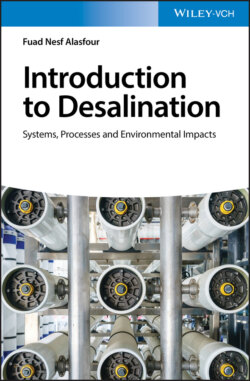Читать книгу Introduction to Desalination - Fuad Nesf Alasfour - Страница 13
1.3 Desalination Processes
ОглавлениеThere are four main industrial desalination processes that exist today to separate freshwater from feedwater, and separation processes can be achieved via:
1 Thermal processes
2 Membrane processes
3 Chemical processes
4 Adsorption processes
Figure 1.2 shows the basic principles of general industrial desalination processes.
Figure 1.2 Basic principles of desalination processes.
Feed can be in the form of seawater with high salinity that can reach a value of 45 000 ppm, or it can be in the form of brackish water or even wastewater that has been taken from industry or municipal.
The example of disposal fluid from desalination system can be in the following forms:
1 Brine fluid (salty water): Which have very high value of salinity that can reach 90 000 ppm in case of thermal desalination system.
2 Concentrate: Which is a fluid with very high value of salinity in case of membrane desalination system.
3 Waste: Which is a product in the form of industrial concentrated fluids.
4 Thick liquor: Product that is produced under specific purposes and applications.
The products from desalination system can be in the following forms:
1 (a) Drinkable water with salinity less than 500 ppm.
2 (b) Fresh water.
3 (c) Fluid with specific required salinity or concentration.
Choosing the proper desalination system (technology) is always a challenge for engineers, because each desalination technology can provide different levels of performance under different circumstances (design and operational conditions). To ensure the performance level for any industrial desalination system, it must be examined in terms of 4E's – energy analysis, exergy analysis, economic analysis, and environmental analysis, in addition to sustainability tendency. Student should remember that selecting desalination system must fulfill the following criteria: low energy consumption, ability to use renewable energy, low cost of water production with high value of quality, and minimum negative environmental impacts, and it must be durable and reliable in operation with minimum required maintenance. Today reverse osmosis (RO) desalination systems present about 65% of worldwide installed capacity, while multi‐stage flashing (MSF) and multi‐effect evaporator (MEE) systems present about 21% and 7%, respectively.
As mentioned before, selecting desalination technology is a great challenge for engineers, and such selection process depends on the evaluation of the following four parameters:
1 Feed concentration: The first parameter that must be considered during desalination technology selection is feed salinity (concentration); the selected system must be able to handle the required salinity and to produce the required water or fluid quality. Figure 1.3 shows the capability of different industrial desalination systems as per feed salinity and produced water purity.
2 Energy consumption: The second parameter that needs to be considered during selection is the value of specific energy consumption (SEC) that is required to desalt feedwater when electrical and/or thermal energies are used. Figure 1.4 predicts the amount of SEC (kWh/m3) per desalination system.
3 Cost: The third parameter that must be considered during desalination selection is the cost of freshwater production (Figure 1.5).
4 Emission: The fourth parameter is the level of emitted emissions of CO2 from desalination that affect the formation of greenhouse phenomenon (Figure 1.6).
Figure 1.3 Different desalination systems' capabilities based on feed salinity and produced water purity.
Source: Youssef et al. 2014 [3]. Reproduced with permission of Elsevier.
Figure 1.4 Specific energy consumption using different desalination technologies.
Source: Youssef et al. 2014 [3]. Reproduced with permission of Elsevier.
Figure 1.5 Cost of potable water production using different desalination technologies.
Source: Youssef et al. 2014 [3]. Reproduced with permission of Elsevier.
Figure 1.6 CO2 released from different desalination technologies measured in kg/m3.
Source: Youssef et al. 2014 [3]. Reproduced with permission of Elsevier.
